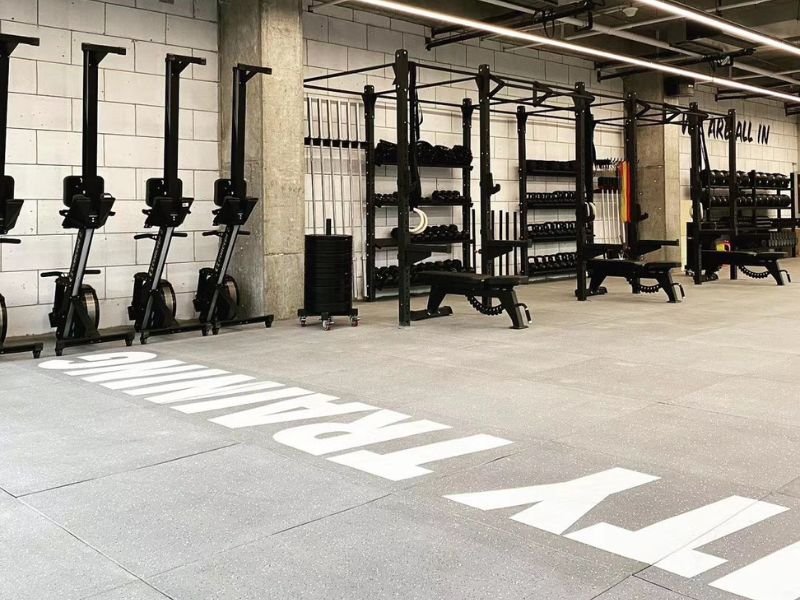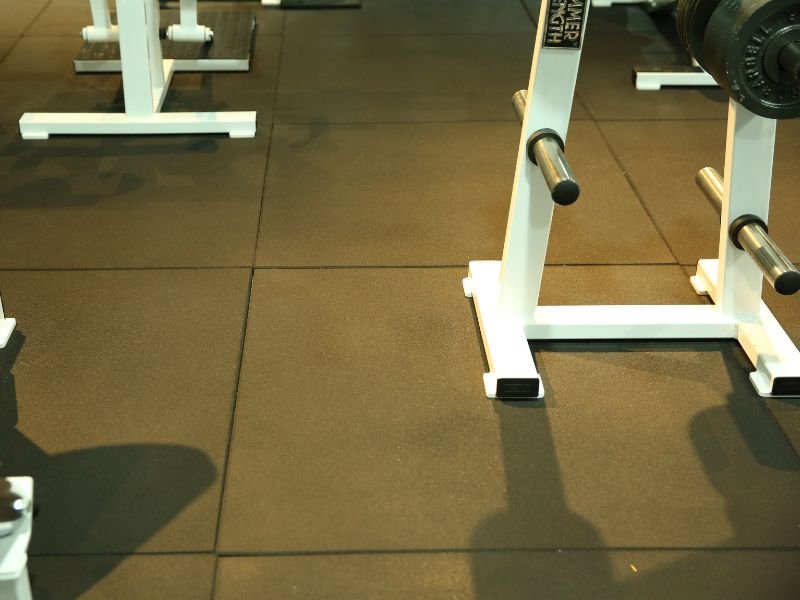Are rubber gym tiles suitable for CrossFit studios?
CrossFit workouts are intense. They involve weight drops, sled pushes, and constant movement. So what kind of flooring can actually keep up?
Yes, rubber gym tiles are one of the best choices for CrossFit studios. They offer shock absorption, durability, and safety.

From my experience supplying to gym owners across Australia, Canada, and Spain, I’ve seen how the right tile makes all the difference in performance and protection.
Why do CrossFit studios need specialized flooring?
CrossFit isn’t like regular cardio or yoga. There’s jumping, dropping, and slamming involved.
Rubber gym tiles provide the support and impact protection needed for CrossFit’s high-intensity environment.
The daily demands of CrossFit
In a typical CrossFit box, flooring must handle:
| Activity | Floor Requirements |
|---|---|
| Olympic lifting | Shock-absorbing and dense material |
| Plyometric jumps | Anti-slip, soft landing |
| Sled pushes | Wear-resistant surface |
| Kettlebell swings | Secure grip underfoot |
Without the right floor, both the athletes and the building structure suffer.
What makes rubber gym tiles ideal?
I’ve helped dozens of gym owners compare materials. Foam is too soft. Concrete is too hard. Rubber tiles hit the sweet spot.
Rubber tiles balance performance, protection, and longevity—perfect for the mixed use of a CrossFit studio.

Benefits of Lanhefloor rubber tiles for CrossFit
We offer several tile types tailored for performance:
| Product Type | Key Feature | Link |
|---|---|---|
| Tiny Granule Rubber Tile | Made of fine SBR, high durability | 🔗 |
| Composite Rubber Tile | EPDM laminated surface, premium appearance | 🔗 |
| Puzzle Rubber Tile | Interlocking, easy install, no glue needed | 🔗 |
These options are built to absorb shock, protect subfloors, and reduce risk of injury during explosive movements.
Thickness matters too. For CrossFit, we recommend:
- 25–40mm for general areas
- 50mm for weight drop zones
What about slipping, noise, and replacement?
Safety and maintenance are major concerns for gym owners, especially in CrossFit environments.
Rubber tiles help solve three key problems: slipping, sound, and maintenance.
Why rubber tiles reduce risk and noise
- Anti-slip texture keeps athletes steady, even in sweat-heavy sessions.
- Shock absorption lowers noise from barbells or kettlebells.
- Replaceable tiles mean if one gets damaged, you swap it out—not the whole floor.
Compared to rubber rolls, tiles give you more flexibility when damage happens. They’re also easier to install in sections.
If your CrossFit space needs both heavy lifting and mobility training zones, you can combine tile types. Many clients choose composite tiles for weight zones and rubber rolls for warm-up or stretching areas.
Do CrossFit studios actually use these?
Yes. Many of our clients from North America, Australia, and New Zealand use our rubber tiles in CrossFit-style gyms.
The most common setup: heavy-duty rubber tiles in lifting zones, rubber rolls or interlocking tiles in lighter areas.

Customer example: Mark from Australia
Mark owns a gym chain and needed flooring that could handle CrossFit classes and personal training. We provided:
- Composite tiles (30mm) in weight zones
- Puzzle rubber tiles (20mm) in PT and mobility areas
- Rubber rolls (8mm) for office and cardio sections
He was especially happy with how easy it was to replace individual tiles after wear.
Don’t forget about certification
All our rubber tiles are EN1177 and CE certified, meeting European standards for safety and impact resistance. This matters if you’re bidding for public or government contracts or want to assure clients about safety.
Explore more high-performance flooring solutions here:
👉 Lanhefloor Gym Rubber Tile Collection
Are there better alternatives to rubber tiles?
For CrossFit, very few. Foam and EVA tiles break down too quickly. Concrete is too hard. Wood is expensive and not impact-friendly.
Rubber tiles provide the best all-around solution—shock absorption, grip, sound dampening, and longevity.
You can also look at our rubber rolls for areas that don’t need individual tile replacements, like warm-up zones.
For outdoor CrossFit setups, consider outdoor rubber floor tiles or EPDM granules for impact-absorbing surface pours.
Conclusion
Rubber gym tiles are the most reliable, safe, and flexible flooring for CrossFit studios. They absorb impact, resist wear, and are easy to maintain—exactly what high-intensity training spaces need.
